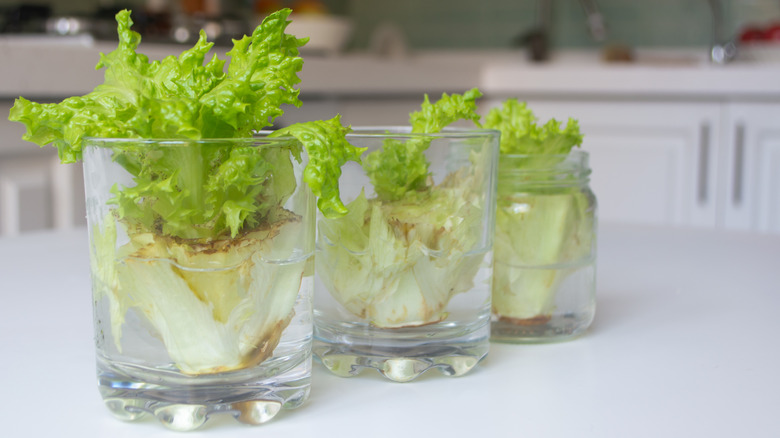Nothing beats having fresh herbs or produce on hand, ready to pluck for the dinner table. It’s incredibly enjoyable to watch them grow, and somehow homegrown always tastes better than store-bought. There are some mistakes to avoid in your indoor herb garden, if you’re planning to go that route, and if you have some room outside and want to give gardening a shot, there are some great vegetable gardening tips to keep in mind. But to regrow leftover lettuce bottoms, the only space you need is a windowsill or countertop. It’s one of many great ways to reduce food waste, and it’s incredibly easy.
Start with a whole head of fresh lettuce. Romaine works great, but so does just about any lettuce. Cut the leaves a couple inches from the very bottom (or butt) of the stalk, put the stalk butt-side down in a bowl or mug, and pour in some water until it covers about half the stalk. Now just give it some light so it can grow. A windowsill works great, but so does anywhere that gets decent light — but not full, bright sun. You should start to see growth in a couple of days, and be sure to change the water every two to three days. You might be amazed at how attached you could become to this little lettuce.
More tips and tricks for regrowing lettuce at home
Your lettuce leaves are ready to be harvested when they’ve grown a few inches long, and you can eat them right away. The plant may continue to grow after the first harvest — up to a couple weeks — but starts to decline since there aren’t enough nutrients in water to keep it going. You may as well cut all of the leaves when you’ve decided they’re ready to eat. Try them in a traditional Caesar salad, use some to brighten up your sandwich, or just bite right into a leaf and enjoy the crunch. These new growth leaves likely taste a little more bitter than the original head of lettuce, but they’re still delicious.
From here you can give your little lettuce more life, but you need to pot it or put it in the garden. Once the roots have developed, it’s much more easily sustained in soil. Simply make a hole in the soil and put your lettuce in, root side down, then cover the stalk to about a half-inch below the base of the leaves. Press firmly to set the roots in the soil and be sure to keep it watered, but not too wet. You’re likely to get at least a couple more harvests if you keep an eye on the little fella, although it doesn’t live forever. But hey, there are even more butts to save — this trick also works great with celery and onions.






